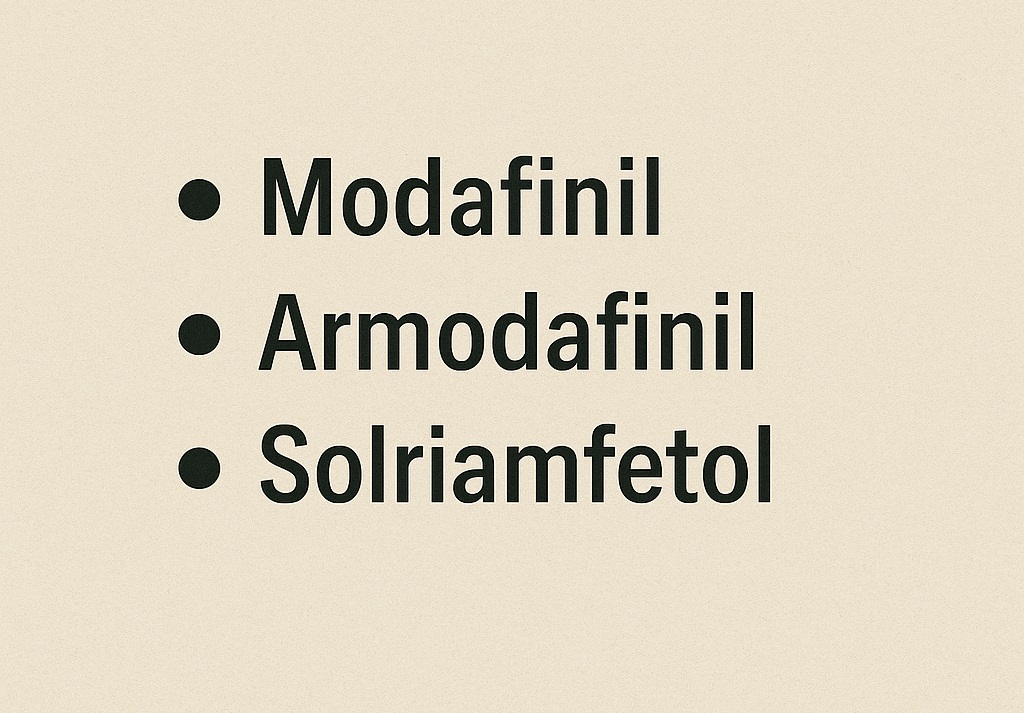Eugeroics, also known as wakefulness-promoting agents, are a class of psychoactive drugs designed to enhance alertness, reduce fatigue, and counteract excessive sleepiness. Unlike classical stimulants, eugeroics generally exert their effects without significantly increasing peripheral sympathetic activity, making them attractive for both clinical and off-label use. This article presents a detailed eugeroic drug list of prominent meds, their mechanisms of action, approved uses, and notable considerations.
1. Modafinil (Provigil)
Overview
Modafinil is the prototypical eugeroic agent. It is FDA-approved for:
- Narcolepsy
- Obstructive Sleep Apnea (OSA)-related sleepiness
- Shift Work Sleep Disorder (SWSD)
Mechanism of Action
Modafinil is thought to increase extracellular dopamine by inhibiting dopamine reuptake, but it also influences orexin, histamine, and norepinephrine pathways.
Key Points
- Half-life: ~12–15 hours
- Common side effects: Headache, nausea, anxiety
- Risk of abuse: Low to moderate
2. Armodafinil (Nuvigil)
Overview
Armodafinil is the R-enantiomer of modafinil and is considered a more potent, longer-lasting alternative.
Mechanism
Similar to modafinil, it targets dopamine transporters, but its pharmacokinetics may lead to a smoother wake-promoting effect.
Notable Use Cases
- Often prescribed when modafinil loses efficacy
- Reported to have fewer “crash” effects
3. Solriamfetol (Sunosi)
FDA Approvals
Approved for excessive daytime sleepiness associated with:
- Narcolepsy
- OSA
Mechanism of Action
Solriamfetol is a dopamine and norepinephrine reuptake inhibitor (DNRI), making it more potent in neurotransmitter modulation compared to modafinil.
Distinct Features
Unique Profile
- Rapid onset and shorter half-life than modafinil
- May increase blood pressure
4. Pitolisant (Wakix)
Pitolisant is the first eugeroic acting as a histamine H3-receptor inverse agonist. This mechanism promotes histamine release in the brain, enhancing wakefulness.
Approved For
- Narcolepsy (with or without cataplexy)
Advantages
- Non-stimulant profile
- Lower abuse potential
- May reduce cataplexy frequency
5. Fluorenol (Unlicensed/Research)
Background
Fluorenol is a novel compound being researched for its wakefulness-promoting properties, with a structure distinct from classical eugeroics.
Potential Benefits
- May exert modafinil-like effects with fewer cardiovascular impacts
- Still under preclinical or early research stages
6. CRL-40,940 (Flmodafinil)
Classification
Flmodafinil is a derivative of modafinil with enhanced pharmacokinetics and bioavailability.
Status
- Not approved by FDA or EMA
- Available in some countries as a nootropic or research chemical
Considerations
- Limited long-term safety data
- Potential cognitive benefits in fatigue or ADHD
Eugeroic drug list Summary Table
| Drug | Main Mechanism | Half-life | Abuse Potential | FDA Approved Uses |
|---|---|---|---|---|
| Modafinil | DAT inhibition | 12–15 hrs | Low-Moderate | Narcolepsy, OSA, SWSD |
| Armodafinil | DAT inhibition (R-enantiomer) | 15 hrs | Low-Moderate | Same as modafinil |
| Solriamfetol | DNRI | 7–9 hrs | Moderate | Narcolepsy, OSA |
| Pitolisant | Histamine H3 inverse agonist | 10–12 hrs | Very Low | Narcolepsy |
| Fluorenol | Unknown/modafinil-like | ? | Unknown | Research use only |
| Flmodafinil | Modafinil derivative | ~12 hrs | Unknown | Not approved |
